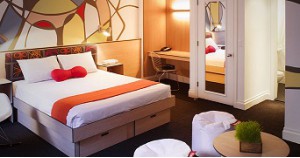Are pod-hotels with micro-rooms destined to be the hotels of the future? The issue is raised by Skift – the global travel industry intelligence forum. They claim several boutique hoteliers are betting big on micro-hotels.
Co-founder of American-based BD Hotels, Richard Born, opened his first pod hotel back in 2007.
“These aren’t small rooms that are cheap,” Born argues. “The materials we use are very high-end and we’ve designed the rooms in a meaningfully important way. You’re sacrificing space, not quality. There’s a niche in the marketplace of people who want high quality and design but also want a boutique feel.”
In purely economic terms pod-hotels make sense in that a 180 sq-ft room of a typical pod-hotel compares with a 325 sq-ft room in a standard three star hotel.
This allows developers to build a third more rooms without having to charge nightly rates that are a third lower.
Advocates of pod-hotels also claims that guests now want to spend more time in lobbies, regardless of their age. They are places for “entertainment, communal tables, virtual concierge walls, giant televisions, local artists, exhibits and tastings.”
Hence they believe guests are spending less time in their hotel rooms compared with 40 years ago.
Hotel bedrooms are functional places to sleep and bathe.
Many pod-hotel rooms don’t have desks as people are working on their laps. Therefore the bedrooms require less square footage.
Makarand Mody, assistant professor of hospitality marketing at Boston University’s School of Hospitality Administration sums up the case for the pod-hotel:
“The room and a comfy bed are simply a place to come back to after a day of experiences, which is why many of these micro-room hotels offer interesting public spaces with innovative dining and social options. So why not make the rooms smaller, but more efficient, and instead provide more to do within the hotel but outside of the room?”
See Skift article: https://skift.com/2017/07/05/pod-hotels-owner-thinking-small-to-grow-big/














































































































































































































































































































































































































































